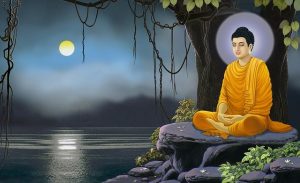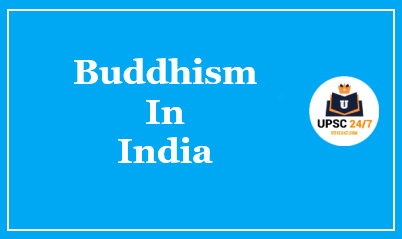Buddha Purnima | UPSC | Why In The news ?
On the occasion of Buddha Purnima, the Ministry of Culture in collaboration with the International Buddhist Confederation (IBC), held a Virtual Prayer Event.
There was a war of words between India and Nepal over the origin of Gautama Buddha.
- Buddha Purnima also known as Buddha Jayanti is an auspicious day that marks the birth anniversary of Gautam Buddha, the founder of Buddhism.
- It is believed that this was also the day he attained enlightenment.
- Buddha Purnima falls on a full moon night, usually between April and May, and it is a gazetted holiday in India.

About Buddha Purnima :
- Born as Siddhartha Gautama, Buddha was a spiritual leader who is the founder of Buddhism.
- Lived from 563 B.C. to 483 B.C.
- Born in Shakya clan in Lumbini, Kapilvastu, Nepal.
- At 29, he abandoned his home and began to live as a homeless ascetic and practiced years of rigorous meditation.
- At 49, Siddhartha sat down under a Pipal tree at Bodhgaya (present day Bihar), where he finally attained Nirvana (perfect enlightenment) and came to be known as the Buddha.
- After this, Buddha gave his first sermon in Sarnath.
- This is called Dhammacakkappavattana Sutta- turning off the wheel of law. The faith of Buddhism was born.
- Buddha passed away in 483 BCE at Kushinagara, Uttar Pradesh.
- This is termed as Mahaparinibban.
Read Also – Buddhism UPSC | Origin | Teachings | Buddhist Councils | Literature
The Five Precepts :
- Refrain from taking life. Not killing any living being
- Refrain from taking what is not given. Not stealing from anyone.
- Refrain from the misuse of the senses.
- Refrain from wrong speech.
- Refrain from intoxicants that cloud the mind.
Bodhisattva
- Bodhisattva is a person who has Enlightenment, but postpones Nirvana in order to help others to attain Enlightenment.
Five forms that represent Buddha are:
- Lotus and Bull – Birth
- Horse – Renunciation
- Bodhi Tree – Mahabodhi
- Dhamma Chakra Pravartana – First sermon
- Footprints – Nirvana
Three pillars of his teachings are:
- Buddha – Founder/Teacher
- Dhamma – Teachings
- Sangha – Order of Buddhist Monks and Nuns
Eight-Fold Paths :
- Right Vision (Samma-Ditthi)
- Right Thought or Attitude (Samma-Sankappa)
- Right or Whole Speech (Samma-Vacca
- Right or Integral Action (Samma-Kammanta)
- Do not tell a lie.
- Do not commit violence.
- Do not covet the property of others.
- Do not indulge in corrupt practices or sensual behaviour.
Buddhist Councils :
1 st Council
- Year : 483 BC
- Venue : Saptaparni Cave, Rajgir
- Chairman :Maha Kassapa
- King : Ajatshatru
- Key Developments : Sutta & Vinaya Pitaka compiled
2nd Council
- Year : 383 BC
- Venue : Vaishali
- Chairman : Sabakami
- King : Kalasoka
- Key Developments : Monks got split into Sthavir madins & Mahasanghikas
The dispute arose over the ‘Ten Points During 2nd Buddhist Council:
This is a reference to claims of some monks breaking ten rules, some of which were considered major.
The specific ten points were:
- Storing salt in a horn.
- Eating after midday.
- Eating once and then going again to a village for alms.
- Holding the Uposatha Ceremony with monks dwelling in the same locality.
- Carrying out official acts when the assembly was incomplete.
- Following a certain practice because it was done by one’s tutor or teacher.
- Eating sour milk after one had his midday meal.
- Consuming a strong drink before it has been fermented.
- Using a rug which was not the proper size.
- Using gold and silver.
The key issue was the use of ‘gold and silver’, which is an Indic idiom that includes any kind of money.
3 rd Council
- Year : 250 BC
- Venue : Pataliputra
- Chairman : Mogalliputta Tissa
- King : Ashoka
- Key Developments : Abhidhammapitaka compiled
4 th Council
- Year : 72 AD
- Venue : Kundalvan, Kashmir
- Chairman : Vasumitra & Ashvaghosha
- King : Kanishka
- Key Developments : Buddhists got split into Hinayana & Mahayana
Note : The Theravada Buddhist council in 1871 and Theravada Buddhist council in 1954 are known as Fifth and Sixth Buddhist Councils respectively.
Buddhist Literature
- Tripitaka or three baskets include the prominent Buddhist scriptures.
- Others include Jatakas, Mahavamsa, Bodhi Vamsa.
Tripitakas
- Vinaya Pitaka : Contains monastic rules of conduct for monks.
- Sutta Pitaka : This scripture describes the first Buddhist council.
- Abhidhamma Pitaka: It is a detailed scholastic analysis and summary of the Buddha’s teachings.
Milinda Panha
- Milinda Panha means ―Questions of Milinda‖.
- It is a dialogue between Indo-Greek king Meander and Buddhist monk Nagasena.
- (Written in Pali)
Dipavamsa
- Dipavamsa or ―Chronicle of Island‖ deals with the arrival of Buddha‘s teaching and preachers in Sri Lanka.
- (Written in Pali)
Mahavamsa
- Deals with the royal dynasties of Indian subcontinent.
- The consecration of Asoka and details of Selucus and Alexander have been detailed in it.
Buddha Charita
- It is an epic poem on the life of Buddha written in Sanskrit.
- It was written by a Buddhist philosopher Ashwaghosha who was a member of King Kanishka’s court.
Source : First Post







